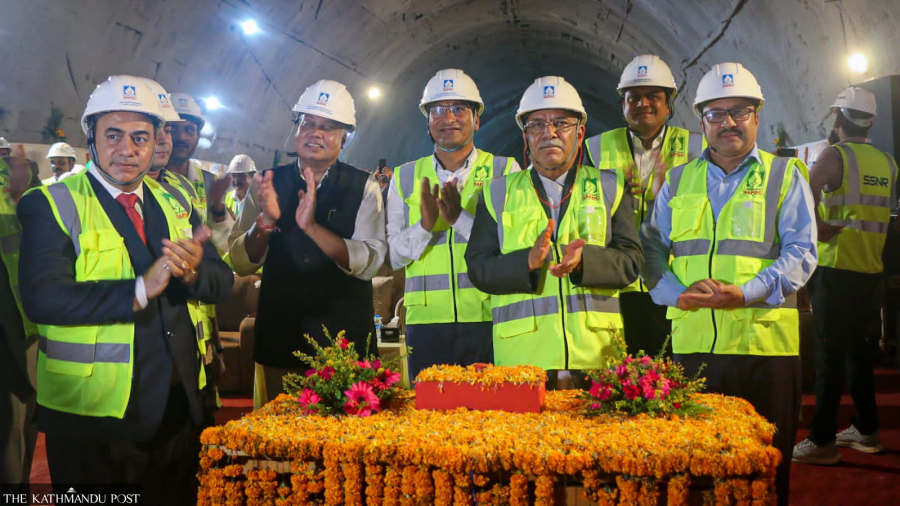Money
Nepal’s first export project achieves tunnel breakthrough
The $1.4 billion Arun III hydro project, which is 900MW and being constructed by SJVN, is expected to start generation by next year.
Dipendra Shakya
Prime Minister Pushpa Kamal Dahal on Tuesday triggered the last blast to mark the breakthrough of the 11.8 km-long headrace tunnel of the 900 MW Arun III Hydroelectric Project in Sankhuwasabha.
The largest hydroelectric plant to date is being constructed by India and is Nepal’s first export-oriented project.
Construction of the $1.4 billion run-of-the-river type project on the Arun River began in May 2018.
The government awarded this project to SJVN, an Indian government-owned entity, through international competitive bidding in March 2008.
The Investment Board Nepal and SJVN signed an agreement for the development of the Arun III project in November 2014.
Speaking at the breakthrough event on Tuesday, Dahal said that the budget for the next fiscal year has announced many measures to attract private sector investment.
He said that the government would allow the private sector to participate in building and operating transmission lines and that necessary laws would be formulated. Nepal plans to add 900 MW of electricity to the national grid in the upcoming fiscal year, bringing the total energy to 4,500MW.
The prime minister also said that the government would facilitate the export of electricity to Bangladesh in the next fiscal year beginning mid-July.
He said the construction of the Dudh Koshi and Nalsingad reservoir project and the Naumure multipurpose project would be completed to meet the dry season's energy demand.
The construction of the Ghunsha and Simbuwaj hydropower projects would also move forward, which is being done by mobilising investment from migrant workers, Dahal said.
Dahal said that this breakthrough brings Nepal and India closer to their goal of providing clean, renewable energy and contributing to the sustainable development of the region. He expressed his appreciation for the ongoing efforts and reaffirmed the government's commitment to facilitating the timely completion of the Arun III project.
Indian ambassador to Nepal Naveen Srivastava recalled in his address that the Prime Minister of India, Narendra Modi, and his Nepali counterpart, Dahal had agreed to a long-term power trade agreement for the import of electricity from Nepal last year, for which completion of the export-oriented 900 MW Arun III would be a major milestone.
Sushil Sharma, chairman and managing director of SJVN, said that the breakthrough of the headrace tunnel marks a crucial step in the progress of Arun III.
Sharma said more than 74 percent of the project work has already been completed, and the remaining work is progressing in full swing. He said work on the 217 km-long associated transmission line is also in progress.
“The successful completion of the headrace tunnel is a monumental achievement in our journey to harness the hydropower potential of the Arun River,” said Sharma.
Sharma further added that the Arun III project will start generation by next year and has the potential to generate 3,924 million units of electricity every year.
"This project symbolises the strong partnership between India and Nepal in the energy sector and our collective efforts to achieve energy security and environmental sustainability."
Currently, SJVN is executing 2,200 MW of three hydroelectric projects in the Arun River basin, including a 679MW Lower Arun Hydropower Project.
In July 2021, Nepal signed a $1.3 billion deal with SJVN to develop the 679MW Lower Arun, the second mega project undertaken by the southern neighbour after the $1.04 billion 900MW Arun III.
The Lower Arun project will not have a reservoir or dam and will be a tailrace development of the Arun III project, which means water will re-enter the river for the Lower Arun project.
The Arun III was slated to start producing energy by 2020, but it didn’t happen as the financial closure deadline was pushed back by a year and a half.
According to the agreement, SJVN will provide 21.9 percent of the monthly generated energy free of cost, which is expected to be equivalent to Rs155 billion, and pay another Rs107 billion in royalties over the next 25 years of its commercial operation.
The project is expected to provide direct economic benefits amounting to Rs348 billion in the form of dividends, income tax, VAT, and customs including the 21.9 energy and royalty over the 25 years of commercial operation after which the project’s ownership will be handed over to the Nepal government.
Arun III was conceptualised in the mid-1980s and redesigned in the nineties as a two-stage project of 201 MW each, planned for funding by a consortium of international donors led by the IDA of the World Bank. However, severe criticism of multiple aspects of the project—its project design, implementation plan, and negative environmental impacts—led to the demise of the project after the World Bank withdrew from the project.
More than a decade later, the project was revived with its installed capacity more than doubled from 402 MW to 900 MW.




 13.12°C Kathmandu
13.12°C Kathmandu














